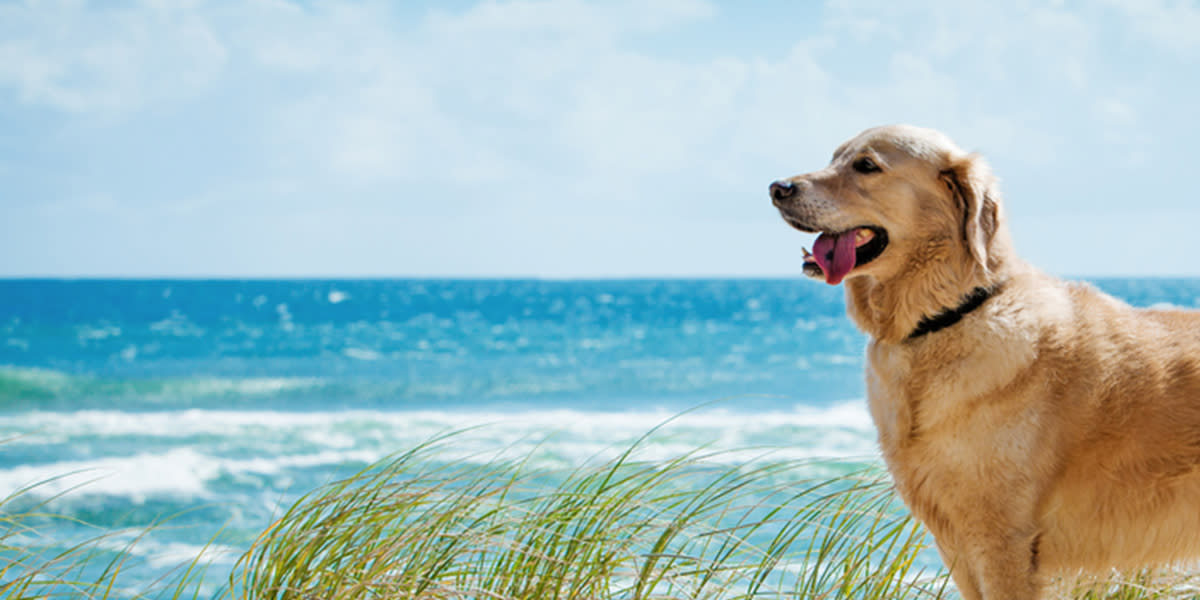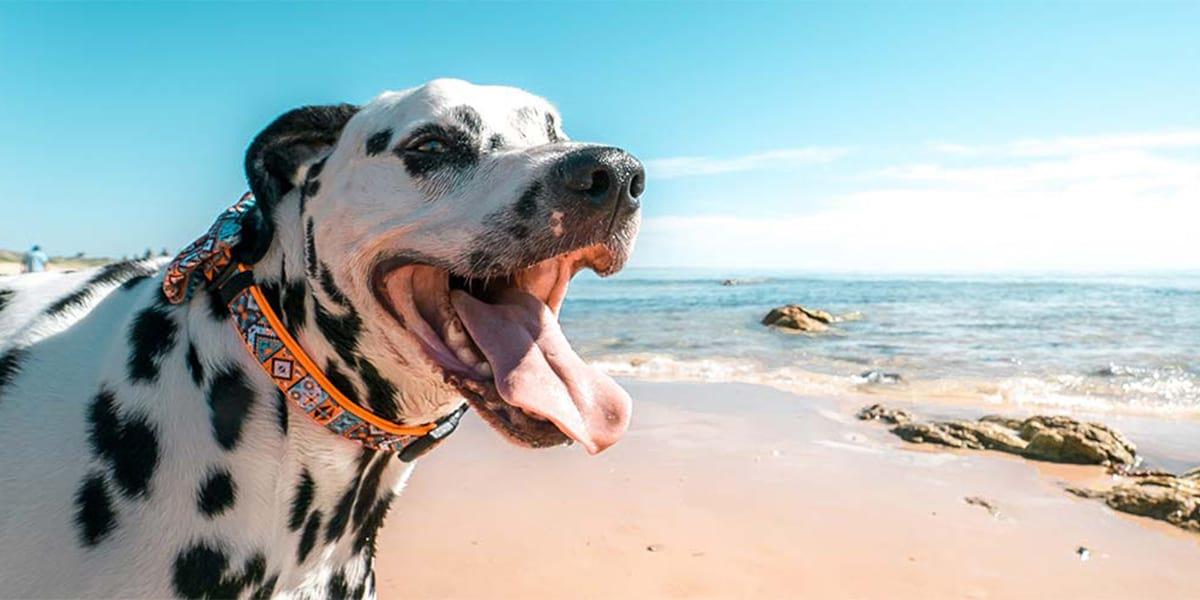
Top Dog Friendly Beaches for a PAWfect Holiday
Our furry friends bring us so much happiness and are often considered part of the family. With approximately 13 million dogs* kept as pets across the UK, many of us love to bring our four-legged companions on our travels. That's why our team at DFDS has researched the best dog-friendly beaches across Europe to help you plan your next short-haul break with your furry pal.
We analysed 1,160 beaches across the continent, taking into account 10 key metrics, including the average number of rainy days across all four seasons, as well as temperatures during those seasons. Google star ratings and average monthly search volumes were also considered to create the ultimate dog-friendly beach guide for Europe.
The Top 25 Dog-Friendly Beaches in Europe
The best dog-friendly beach in Europe is none other than Durdle Door, home to the iconic cove and neighbouring the Jurassic Coast – this beach received an index score of 68.4 out of 100. With the largest search volume across all 1,160 dog-friendly European beaches analysed, Durdle Door received an average monthly search of 110,000 – its crystal waters are clearly in high demand.
Leah Brown, dog-parent to four-year-old Cavapoo, Saphy, loved their trip to Durdle Door. She said:
“Saphy loves the beach. Sandy or pebbled, she’s not fussy.” “The walks around Durdle Door are almost hard to beat. The high coastal paths make it really good for circular walks (mind the sheep poo!), with rest/hydration stops at pubs or towns along the way. “It’s possible to find shade on the beach, and if it’s not heaving with people (I tend to go to tourist attractions out of season when it’s raining and blustery or in early spring), it’s a great place to chuck a ball about or go for a shallow swim.”
Leah added her top tips for when you and your dog hit the beach. She advised:
You should "always carry a separate bottle of water for your dog. “Saphy is good at managing her own temperature on the beach and will happily sit in a puddle like a beached whale to cool down, but many dogs don’t. Assume they are too hot. “Check the ground isn’t too hot for their pads. Don’t assume they want to sunbathe with you. Do look at their pupils and check for signs of redness or glazing over. “But also try to have fun. If you’re there with your pooch, they will be delighted. And always buy them a doggy ice cream!”
The second-place spot goes to Playa de la Rana Adra in Southern Spain. With an index rating of 67.7 out of 100, this dog-friendly beach is perfect for a summer holiday with your beloved pooch, as it ranks among the beach destinations with the lowest number of rainy days across all four seasons. In fact, it has an average of no rainy days in the summer. Despite not receiving monthly searches like Durdle Door, this Spanish beach received a 4.3 Google star rating from locals and dog parents. It may fly under the popularity radar, but it is definitely worth a visit!
Rounding off the top three dog-friendly beaches in Europe is Cala de Mijo. This Spanish beach earned itself an index rating of 67.4 out of 100. Like our second-place winner, Playa de la Rana Adra, Cala de Mijo ranked highly for the lowest number of rainy days across all seasons. With clear skies and a Google star rating of 4.2, we recommend visiting sunny Cala de Mijo.

Durdle Door Ranked as the UK’s Most Dog-Friendly Beach
Ranking as the best dog-friendly beach across Europe, it’s no surprise that Durdle Door also nabs the top spot for the UK’s most dog-friendly beaches. However, Fistal Beach comes in at a close second, with an index score of 86.5 out of 100. Although it's famous for being a surfer's paradise, it's also an excellent option for dog owners. During the summer months, Fistal Beach has an average of just seven rainy days and an average temperature of 20 degrees, making it an ideal place for a sunny stroll with your furry friend.
Securing England's third spot is Crosby Beach in Merseyside, with an index score of 86.4 out of 100. This beach has areas of soft sand and mud, so we recommend bringing a towel for when you put your pup back in the car.
Across the UK, Ballycastle came out on top for Northern Ireland, with an index score of 72.7 out of 100, as well as Canty Bay in Scotland and Flimston Bay in Wales, with index scores of 77.8 and 77.6, respectively.

The UK's Best-Kept Secrets: A Guide to Dog-Friendly Beaches
Like many stunning dog-friendly beaches, the reputation of their breathtaking vistas and pristine turquoise waters spreads quickly through word of mouth. So, our team at DFDS also analysed lesser-known spots using the same set of metrics. However, in this case, we focused on analysing highly acclaimed dog-friendly beaches with lower Google search volumes to assess their level of local popularity.
Goswick Sands, located between the border of Scotland and Holy Island, took the top spot as the UK’s locally ranked dog-friendly beach, with an index score of 94.6 out of 100. With golden sands, a five-star rating on Google, and an average of 50 monthly searches, it's time to head there before this hidden gem gets discovered!
Crimdon - Park in County Durham and Bournemouth's Fisherman's Walk followed closely in second and third place, with index scores of 94.3 and 93.8, respectively.
Debby Lucken, Dog behaviourist at Kids Around Dogs gave her expert tips on how to keep your dog safe when venturing to the beach.
“When the weather is hot or you know, the temperature is going to rise during the day, make sure to take your dog for a walk early in the morning or late in the evening.”
Debby continued by advising the temperatures you should watch out for:
“Always check the surface with the back of your hand, if they feel too hot for you, they will certainly be too hot for your dog. Bear in mind that with a temperature up until 23C is fine for dogs to be out and about, however, if the temperatures go from 24C, it starts to get rather dangerous for dogs to be exercised outdoors and if it reaches above 30 C the dog is at a very high risk of heatstroke.”
“It’s important to note that some breeds of dogs are more at risk of heat stroke than others, such as;
- Flat-faced dogs (Pugs, French Bulldogs, English Bulldogs, etc.)
- Long-haired dogs (Bearded Collies, Lhasa Apso, etc.)
- Young puppies (generally under 6 months old)
- And senior dogs (generally over 7 years old).
“If your dog has some health issues, consult your vet before going away with your dog to make sure she can travel safely. Be honest with the duration of your journey, the type of holidays you will have and how long you would like to be relaxing at the beach for. Your vet will best advise you, considering the health and possible medications your dog is on.”
She also advised on the heatstroke symptoms dog parents should look out for:
- Looking weak and lethargic (walking very slowly, or not walking to move much at all)
- Panting excessively
- Drooling (or more than normal, if the dog breed drools naturally)
- Being excessively thirsty
- Vomiting
- Diarrhoea
- Collapsing.
“If you suspect your dog might be overheated and might be experiencing heatstroke, do not wait, call the vet immediately.”
Here are Debby’s must-have items to pack in your doggy bag before you head to the beach:
Cooler box or bag (separate from your cooler box/bag) - this will help keep your pooch's food, water and treats cool and refreshing.
Travel bowl – collapsible travel bowls are the perfect solution to mealtimes and hydrating your four-legged pal.
Harness and lead – this of course go hand in hand when you’re spending the day out with your dog. Keeping them on the lead helps avoid problems or scuffles with other dogs and ensures everyone's safety.
Medical record and any medications – keeping a record on your phone of your dog's illnesses or medication can not only be handy but potentially lifesaving.
Beach umbrellas – while they may not fit your doggy bag, they’re a must for allowing your dog to have a prime spot in the shade at all times. Having a wet towel for your dog to lie on and cool water in easy reach can also help keep your pooch cool during warmer temperatures.
Poo bags and cleaning wipes – wipes can always come in handy whether you need to wipe down your dog after their beach run, or if they are sick or need the toilet. Poo bags are of course a must, you should always pick up your dog and dispose of it appropriately in the nearest dog bin.
Travelling to the beach by car? Debby also added her four top tips when travelling in the car with your dog, so their journey is as peaceful as possible:
Don’t give your dog a big meal right before setting off on your journey, this can upset your dog’s tummy and bring on motion sickness. It’s best to give them little and often when you stop to stretch their paws.
Make sure to stop for little breaks when your journey is between 1 ½ to 2 hours long. Stopping gives them a chance to have a toilet break, refresh with a drink and of course, have a stretch and nose. You should always make sure your dog is on the lead while they're sniffing around looking for the perfect wee spot.
Always make sure you follow driving laws. Rule 57 of the Highway Code states that ‘when in a vehicle make sure dogs or other animals are suitably restrained so they cannot distract you while you are driving or injure you, or themselves if you stop quickly.’ You can use a carrier, a dog crate, a dog safety harness, or a dog guard.
Finally, if you stop never leave your dog in a hot vehicle!

Travelling with your pet with DFDS
As part of the DEFRA Pet Travel Scheme (PETS), we provide safe transportation for your pets on board our ferries. You will have the opportunity to visit your pets on longer crossings, as arranged by the onboard staff. Our Newcastle to Amsterdam and Copenhagen to Oslo crossings even boast pet-friendly cabins.
Please note: bringing birds on board our Newcastle to Amsterdam route is no longer allowed. This applies to all types of birds.
Methodology
According to the European Environmental Agency, there are almost 22,000 salt and freshwater beaches across Europe. From that, a seed list of 1,160 ‘dog friendly’ beaches were determined from local environmental authorities across Croatia, England, France, Holland, Northern Ireland, Italy, Scotland, Spain*, and Wales. This list was then compared against Google reviews and denoted dog park spaces online. Due to the nature of a cross-authority study, both off-leash and leashed beaches are counted as ‘dog-friendly’ for demonstrative purposes. Always check with your local authority for up-to-date rules and regulations. For every beach, the monthly search volumes and user Google ratings were collated to provide contextual data surrounding the quality and popularity of our ‘dog friendly’ beaches. Weather data from each beach’s local weather station was added to provide seasonal weather insights. The data points were combined before being processed into a 0-100 scoring system to determine the quality of the comparable beaches using standard deviation. Weightings were judged by a panel and determined on consensus.
Sources
Beaches
- European Environment Agency
- Google Maps
- Google Reviews
- Yelp comments
- Google Analytics
- Semrush
Weather
- metoffice.gov.uk/
- aemet.es/es/portada
- ipma.pt/pt/index.html
- knmi.nl/klimaat-viewer
- met.ie/
- dwd.de/
- donneespubliques.meteofrance.fr/
- meteo.be/nl/brussel
- mistralportal.it/opendata/
Disclaimer
When walking a dog and planning trips, be sure to strictly observe leashed and off-leash areas to avoid liability or fines. This piece is for entertainment purposes and DFDS accepts no liability for errors relating to dog walking rules at the locations included in this content. This list is neither exhaustive nor fixed, and local rules should always be observed.
References
*statista.com/statistics/515379/dogs-population-in-the-united-kingdom-uk/
